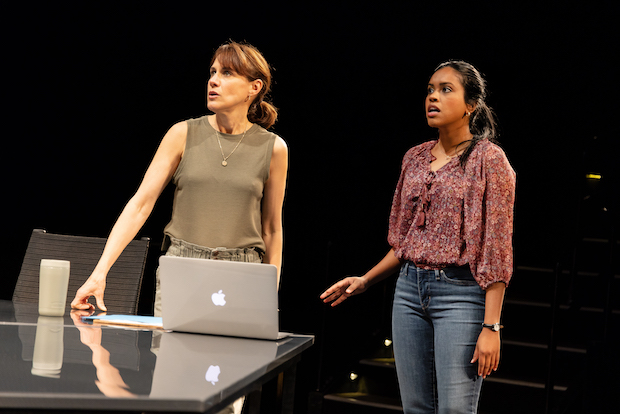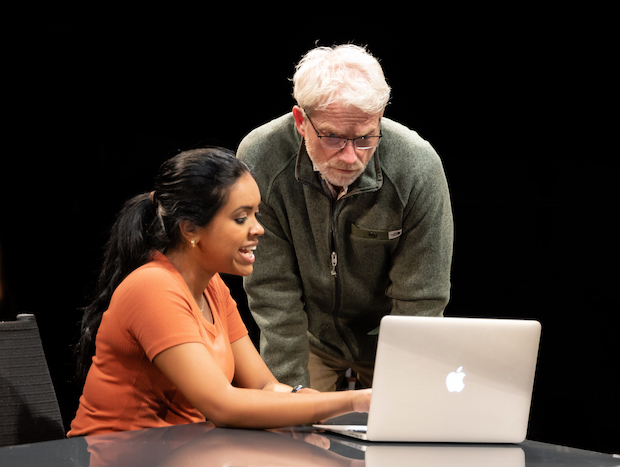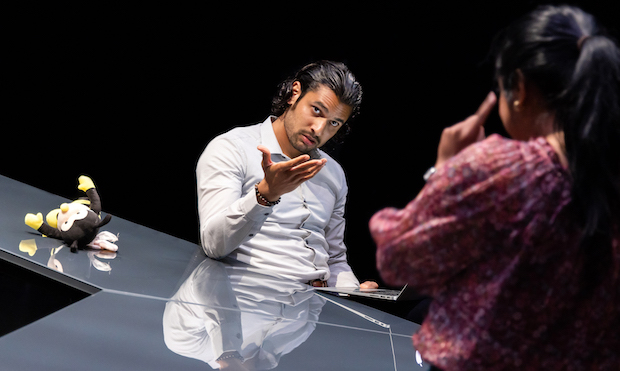Review: Queen Buzzes With Drama, Both Intellectual and Emotional
National Asian American Theatre Company presents the off-Broadway premiere of Madhuri Shekar’s play at A.R.T./New York Theatres.

(© Jeremy Daniel)
Madhuri Shekar's Queen, making its off-Broadway premiere with the National Asian American Theatre Company, revolves in large part around the efforts of two scientists to reconcile a sudden statistical discrepancy that threatens to discredit a study on the decimation of honey bees that they have been working on for about six years. That sounds like incredibly dry subject matter on the surface, so Shekar deserves credit for mining gripping human drama out of it without dumbing it down or condescending to her audience. It also helps that Shekar has much more on her mind than just that one particular hot-button scientific/mathematical subject.
Crucially, the two scientists in Queen are women: mathematician Sanam Shah (Avanthika Srinivasan) and ecology researcher Ariel Spiegel (Stephanie Janssen). Their relationship is at the center of Shekar's play, especially as the aforementioned discrepancy threatens not only their impending professional breakthrough — their study is about to be published in the prestigious Nature magazine — but also their friendship and individual professional ambitions. Some of those ambitions are indeed tied to their gender, with their supervising professor, Dr. Philip Hayes (Ben Livingston), to some degree representing the white-male majority of the scientific community in which Sanam and Ariel are trying, in their own ways, to break through.

(© Jeremy Daniel)
But Ariel in particular is also driven by activist zeal. A single mother who has been passionate about honey bees since childhood, she becomes especially distraught when Sanam discovers that recent data have put a damper on their previously well-supported conclusion that pesticides created by biotech company Monsanto were a leading cause of colony collapse disorder. Sanam, however, is driven more by numbers than by passion — a worldview to some degree reflected in the play's fourth major character, Arvind Patel (Keshav Moodliar), a New York City-based financier and potential romantic interest for Sanam who has a similar facility for statistics but is less tied to his day job than Sanam is. It's during their mixed bag of a first date that Arvind suggests the devastating possibility that Saman and Ariel's study may be tainted by confirmation bias.
In short, Queen aims to do much more than just shine a light on an ecological problem. At heart, it dramatizes the eternal conflict between logic and emotion, and how such a dichotomy can even manifest itself in the realm of science. It's the depth of Shekar's characterizations, the way Sanam and Ariel, especially, feel like three-dimensional people, that allows the play transcend its activist and allegorical trappings.
Excellent performances, under the direction of Aneesha Kudtarkar, also help in this production. Moodliar brings puckish scene-stealing energy to his scenes as Arvind, charming and funny even when he's defending Monsanto and pushing too hard for Sanam's affections. By contrast, Livingston radiates a paternal authority that becomes threatening when the play's central scientific and interpersonal conflict comes to a head. But Srinivasan and Janssen are the stars of this production, and they exude an easy rapport that feels authentically long-standing. Their one big confrontation scene — in which Ariel desperately suggests a solution to their statistical problem that Sanam considers deeply unethical — crackles with nerve-racking tension, a breathtaking demonstration of live theater at its best.

(© Jeremy Daniel)
Kudtarker has surrounded her actors with a sleek-looking, spare production that eschews realism in favor of a more expressionistic bent. Yuki Nakase Link douses A.R.T/New York Theatres' Mezzanine Theatre in noirish lighting that gives the space the feel of a mission-control room, with the collective UptownWorks' (consisting of Daniela Hart, Noel Nichols, and Bailey Trierweller) electronic sound design, punctuated with buzzing noises, adding to the clinical feel during scene transitions. Junghyun Georgia Lee's scenic design is the most imaginative of all, however. Consisting merely of five black tables arranged in a honeycomb formation that, midway through the play, breaks apart, Lee's simple set functions as a poetic metaphor for the play's main dramatic arc: the shattering of scientific certainty.
It's that shattering that gives Queen a deeper resonance beyond its immediate topical concerns. In her play, Shekar creates a dialectic between two extreme perspectives — one based on cold, hard facts; the other more willing to bend facts in search of a greater perceived truth — and finds that there may be more correspondence between them than initially assumed. It's a play that, at its best, satisfies both the head and the heart.








